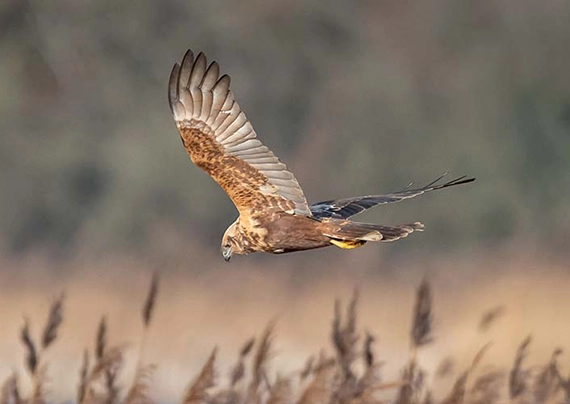
Marsh Harriers have always been part of the avifauna of the UK, but numbers dropped dramatically as the fens and wetlands in the east were drained for agriculture. The population took a further hit in Victorian times, as birds were targeted as predators by hunters, farmers and landowners at the same time eggs were being collected or destroyed, and habitat continues to be lost. By the late 1800s they had become extinct in England and the last pair bred in Ireland in 1917. Occasional birds, almost certainly originally from the continent, bred in Suffolk and Norfolk, with the core being at Minsmere reserve, but numbers increased in fits and starts up to the 1950s. A resurgence was expected but numbers crashed again, and by 1961 no Marsh Harriers bred in the UK. This time it is believed that the population crash was caused by the use of organochlorine pesticides, especially in their Scandinavian heartland. They did maintain a toehold, with one nest annually at Minsmere until the use of pesticides was banned. Numbers began to climb once again and now, thankfully, these magnificent birds are an integral part of the fens, marshes and reedbeds of Eastern England.
Key Facts
Common name: Marsh Harrier
Scientific name: Circus aeruginosus
Habitat: Reedbeds and other well vegetated habitats
Diet: Small mammals, birds, insects, reptiles, frogs and even, on occasion, fish
Size: Average 52cm, wingspan 122cm. Females (670g) larger than males (540g)
Status: Resident breeding bird. Migrant and passage visitor
Population size: 590 pairs
Conservation status: AMBER (recovered from historical decline, but recent population and range declines)
Appearance
They are sexually dimorphic in plumage, with adult females a handsome chocolate brown colour with cream heads and forewings, whereas the males have a complex pattern of brown, russet and grey. Juveniles tend to have a female-like plumage. Study of a number of birds of known age, however, has shown that plumage in Marsh Harriers is not straightforward, with some older birds having juvenile-type plumage, and some old females developing male-type plumage! They are quite large birds, heavier and sturdier than our other harriers, and have long wings often held in an upward ‘V’ shape, reminiscent of Buzzard or Black Kite which can cause a confusion, especially when encountered away from their usual wetland habitats. However, the low, inconspicuous quartering back and forth over the hunting site is characteristic. Marsh Harriers are not closely related to the other harrier species found in Britain but form a group of species which occur across Asia, Indian Ocean islands and Australia.
Lifespan
The average lifespan is 6 years, with an adult survival rate of 74% year on year. First year survival is not known, but birds have a 15% chance of reaching their third year, when they will begin breeding. The oldest known wild bird in the world, was 6½ years old (ringing recovery).
Nesting
Invariably, Marsh Harriers nest on the ground in long vegetation. British Marsh Harriers have always nested in reed beds, although in Europe they nest in rank vegetation and even in agricultural crops. Since recolonising, some British harriers are starting to show a wider breeding habitat, with records of crop-breeding and even moorland-breeding. This change of behaviour should offer opportunities for the recovering population. It is common for males to support more than one female. On occasion one male may be paired with three females, although breeding success is often lower as the male is not able to provision all the nests and chicks sufficiently.
Number of eggs: 4-5
Incubation: 31-38 days
Fledging time: 35-40 days
Habitat and Distribution
Marsh Harriers are still very much birds of eastern England, centred on East Anglia and the eastern coast. Small populations also occur in a number of places, most notably Lancashire and Dorset. In winter, as birds range more widely, they may be encountered anywhere but are still very rare outside of their core areas. During the breeding season, Marsh Harriers are typically seen in extensive reed beds, but a few can be found in other open, well-vegetated habitats. After breeding, birds range more widely, and can be found in coastal areas and even quartering fields; in East Anglia, some seem to favour stubble fields in the autumn
Movements
It is almost certain that the recolonising birds originated from Europe, and for many years Marsh Harriers were regarded as migrants, but in fact birds are more likely to remain all year. As birds are three before breeding, they spend their first two years ranging widely away from where they were hatched, and this may include leaving the country, through southern Europe and even as far as Africa (several wing-tagged birds have been recorded south of the Sahara). It is likely that some adult individuals will leave the country, whilst others show remarkable loyalty to their territorial areas. Birds may appear at winter harrier roosts with Hen Harriers.
Feeding
Marsh Harriers are catholic in their diet but prefer to take their prey from the ground. They will target small mammals, birds, insects, reptiles, frogs and even, on occasion, fish. As with other harrier species, they can exchange food with their mates in mid-air.

